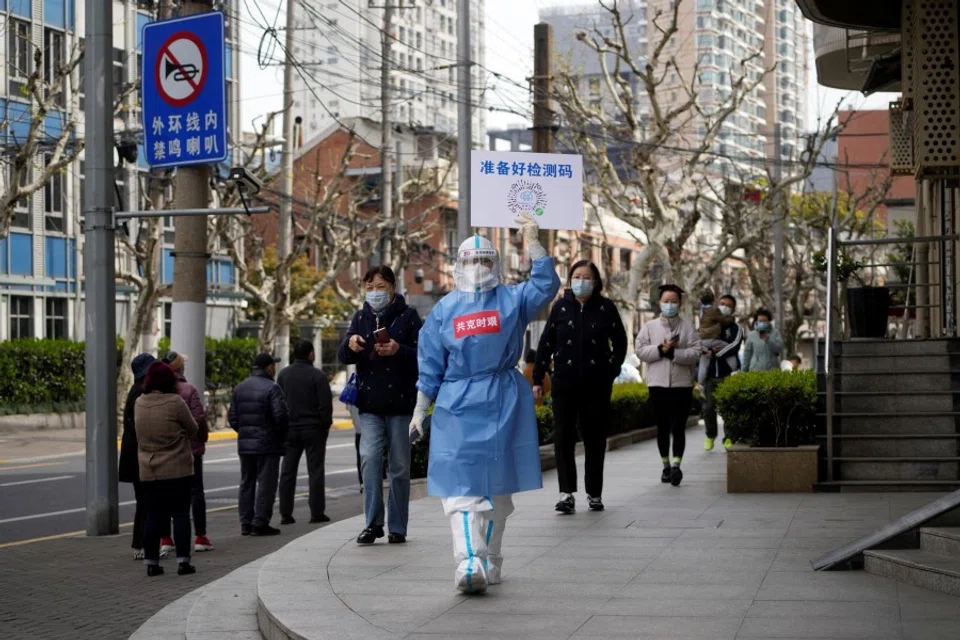How China's health code app permeates daily life and may still play a role post-Covid
China's use of the health code for pandemic control has illustrated the potential of digital technologies in the 21st century. However, there are concerns about the blurring of the lines between digital surveillance and public service provision, and fears that tech giants and local governments will take advantage of the greater access to personal data they have been given.

China has harnessed the power of technology in its fight against Covid-19.
By mid-February 2020, Hangzhou and Shenzhen had rolled out the health code app. Essentially, a green QR code allows people to move around, a yellow code requires a seven-day home quarantine and a red code a 14-day home quarantine.
By the end of March 2020, the rollout of health code apps with local variations had reached every corner of the country. In the two years since then, the health code system has profoundly shaped the everyday life of 1.4 billion Chinese.
The health code marks a transition from traditional pen and paper-based health declarations and printed permissions for work and travel to a digital way of epidemic prevention and control.
Arguably the world's largest experimentation with the use of digital technology for social governance, the Chinese experience provides a glimpse into the promises as well as perils of data-driven governance in the 21st century.
Government-business tech collaboration a key factor
A growing government-business tech collaboration in search of digital solutions to real-world problems played a big role in spearheading such development.
The health code rollout started as a local initiative, launched independently in Hangzhou and Shenzhen in mid-February 2020. The two cities took the lead because the two municipal governments wanted targeted quarantine measures rather than a full-scale lockdown so that work and production could resume amid the anticipated large migration inflows after the Chinese New Year.
...tech firms are now talking about commercialising the health code in the post-Covid era, in sectors such as online medical services or home care services for targeted populations.

Equally important, the two cities are the host of the headquarters of Alibaba and Tencent respectively, which provided the needed digital platforms - Alipay and WeChat - and big data expertise to develop the health code apps.
A sense of social responsibility was a major motivation as experts/engineers from Alibaba or Tencent worked in shifts round the clock. Nonetheless, another impetus from the very beginning was the multi-billion market for health code apps. The two companies sent their teams to other cities and provinces in February and March 2020 in a tense competition to vie for the big slice of the pie.
Through the health code, Alibaba and Tencent have expanded their footing in health governance. Observers note that they have been deeply involved in local and national standards-setting for the health code.
Moreover, through the health code apps, Alibaba and Tencent have expanded their access to data previously controlled by different government agencies. With the health code amassing enormous amounts of health data, itinerary data and facial recognition data, tech firms are now talking about commercialising the health code in the post-Covid era, in sectors such as online medical services or home care services for targeted populations.
The health code has significantly lowered the barriers of access to various information, as the health code app requires data sharing from different sources.
Local governments at the provincial and city level are another major driver in launching the health code. One hurdle in the past was the prevalence of "information silos" between different government agencies. The health code has significantly lowered the barriers of access to various information, as the health code app requires data sharing from different sources.
These sources and information include health data controlled by the health bureau, identity document and residence data from the public security bureau, itinerary data owned by telecoms and distributed by the Ministry of Industry and Information Technology, and on-the-ground data/household data collected by grassroots organisations.
In many provinces and cities, the operation of the health code has empowered their big data bureau or similar agencies.
Blurring the lines of digital surveillance and public service provision
Another feature of China's health code has been the fusion of digital surveillance and public service provision.
Increasingly, the health code app has been integrated into the e-platforms of local government services, through a link to local residents' electrical health cards and social security cards, and to portals for making medical appointments. The health code has blurred the boundary between social control/surveillance and public service delivery.
Digital technologies are an effective solution only when and where the right conditions - from a compliant public to an adequate infrastructure of resources and capacity - are present.

China's use of the health code for pandemic control and the resumption of work and production has illustrated the potential of digital technologies in the 21st century. Thinking along the lines of "technological empowerment", those who are optimistic take a forward-looking view of the promising future of digital technologies for private businesses, public management and social governance.
Others who are less sanguine point out that the health code app alone cannot do wonders. China's fight against Covid-19 depends not only on the health code, but also on the system's ability to deploy staff and resources to the frontline and a high level of public adherence to safe management measures such as quarantine and mass testing. Digital technologies are an effective solution only when and where the right conditions - from a compliant public to an adequate infrastructure of resources and capacity - are present.
There are also concerns about the perils of intrusive digital technologies. As evidenced in the case of the health code, digital technologies are likely to empower tech giants and local governments, while leaving ordinary citizens in a vulnerable position.
The problem is not just the opaque nature of logarithm. When the society is divided and governed by colour-coded designations, social anomalies will likely take over, resulting in the social fabric being damaged and tragedy being brought to individuals and families.
...it is also important to maintain a balance between the tech power of big corporations and digital platforms, the administrative and regulatory power of the state, and the interests and rights of the public.

Shanghai's lockdown in April 2022 best illustrates what can go wrong with the overuse of digital surveillance. As the quarantine rules apply equally to essential businesses and service workers, "choke points" in food and service delivery become rampant. Residents who have not stocked up on food face starvation while those with health problems are worried about medical emergencies. Frustration and fury grow as residents have to undergo neverending PCR testing and are nowhere to escape for weeks despite being tested negative.
If there is any lesson to be learnt from China, it is that China's use of the health code for pandemic control demonstrates the potential of digital technologies in the 21st century. However, it is also important to maintain a balance between the tech power of big corporations and digital platforms, the administrative and regulatory power of the state, and the interests and rights of the public.
An initial version of this article was first published as an East Asian Institute Background Brief.
Related: Pandemic in China: Will Beijing repeat Shanghai's mistakes? | As the virus spreads, can China calm its people and contain the outbreaks? | Shanghai's worsening Covid-19 outbreak is turning political | Shanghai's Covid shutdown is disrupting domestic and global supply chains | Can Shanghai meet its zero-Covid deadline and resume production?
